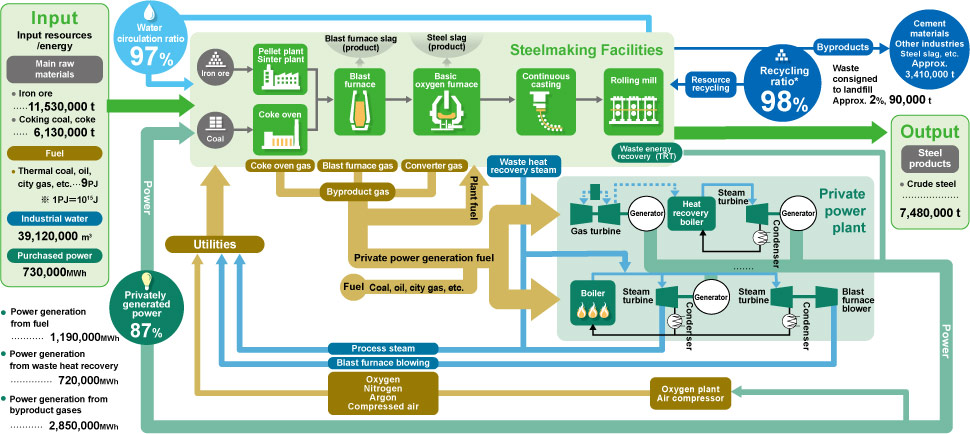The Kobe Steel Group undertakes environmentally conscious management through every aspect of its operations.
As part of this approach, the Group continuously strives for greater energy efficiency; effective use of byproduct gases, waste heat, water and other resources; and the recycling of byproducts.
At Kobe Steel, 94 percent of energy use is in the Iron & Steel Business. In fiscal 2015, this business unit used 11.53 million tons of iron ore, 6.13 million tons of coking coal and coke, 9PJ*1 of fuels such as coal, oil and city gas, and 730,000 MWh of purchased power. Nearly all of the byproduct gases – including coke oven gas, blast furnace gas and converter gas – derived from production processes are effectively reused as fuel for reheating steel or for use in in-house power plants. Kobe Steel also proactively implements power generation that utilizes waste heat. Combined with the power generated from byproduct gases, over 60 percent of the power required by production processes is generated through energy recovery.
Insofar as possible, byproducts produced during production processes, such as steel slag*2, dust and sludge, are also turned to effective use as raw materials in applications such as cement and roadbeds. Together with in-company reuse, 98 percent of the byproducts are recycled in this manner.
In the future, Kobe Steel will continue to carry out environmentally friendly practices throughout all aspects of its operations, striving for more efficient use of resources and energy and advancing the development of new technologies to that end.
*1 1PJ=1015J
*2 Iron and steel slag is a byproduct separated and recovered during iron and steel refining.
(It is also called blast furnace slag or steelmaking slag.)
Resource and Energy Use in the Iron & Steel Business (Fiscal 2015)

Using metal wire rods, hoops, fluxes, soluble glass and other raw materials, the Welding Business produces welding electrodes and welding wires. In fiscal 2015 the Fujisawa, Ibaraki, Saijo and Fukuchiyama plants used a combined 170,000 tons of raw materials, 62,000 MWh of electricity, and 0.2 PJ of city gas and other fuels to manufacture 160,000 tons worth of products. This generated 15,000 tons of byproducts, of which 98 percent was successfully recycled.
Resource and Energy Use in the Welding Business (Fiscal 2015)
| Input | Output | |||
|---|---|---|---|---|
| Raw materials | Products | |||
| Wire rods, hoops, fluxes, soluble glass, etc. | 170,000 t | Welding rods, welding wires, etc. | 160,000 t | |
| Energy | Byproducts | |||
| Purchased power | 62,000 MWh | Amount produced | 15,000 t | |
| City gas, etc. | 0.2 PJ | Recycling ratio | 98% | |
Using ingots and scrap as raw materials, the Aluminum & Copper Business produces a variety of aluminum and copper products. In fiscal 2015 the business unit used 470,000 tons of raw materials, 500,000 MWh of electricity, and 4.4 PJ of city gas and other fuels to create 430,000 tons of products. During melting and casting, 31,000 tons of byproducts, such as slag, dust and wastewater sludge, were produced. However, 96 percent of these byproducts were successfully recycled.
Resource and Energy Use in the Aluminum & Copper Business (Fiscal 2015)
| Input | Output | |||
|---|---|---|---|---|
| Raw materials | Products | |||
| Aluminum ingots, copper ingots, etc. | 470,000 t | Aluminum and copper products | 430,000 t | |
| Energy | Waste | |||
| Purchased power | 500,000 MWh | Amount produced | 31,000 t | |
| City gas, etc. | 4.4 PJ | Recycling ratio | 96% | |